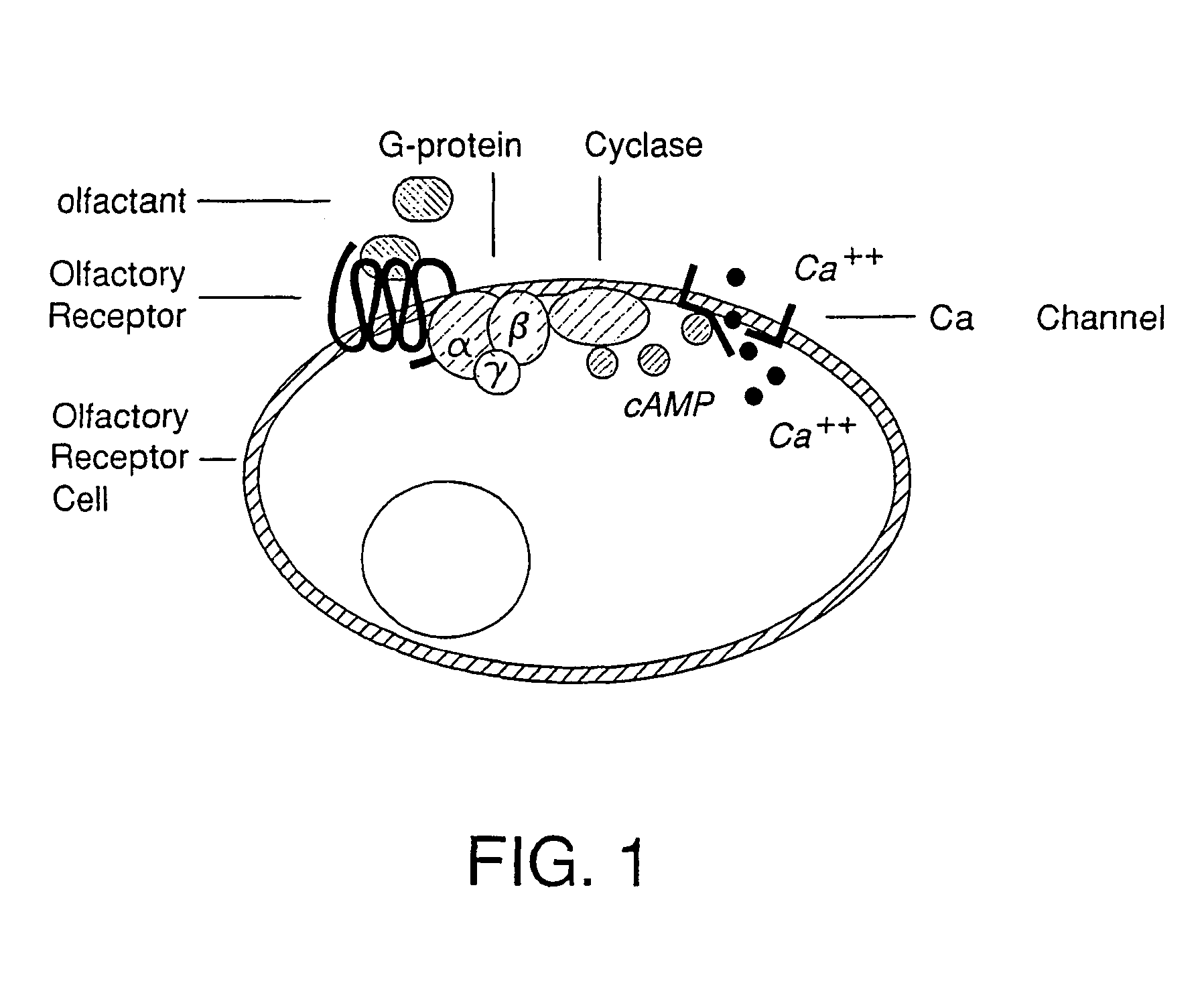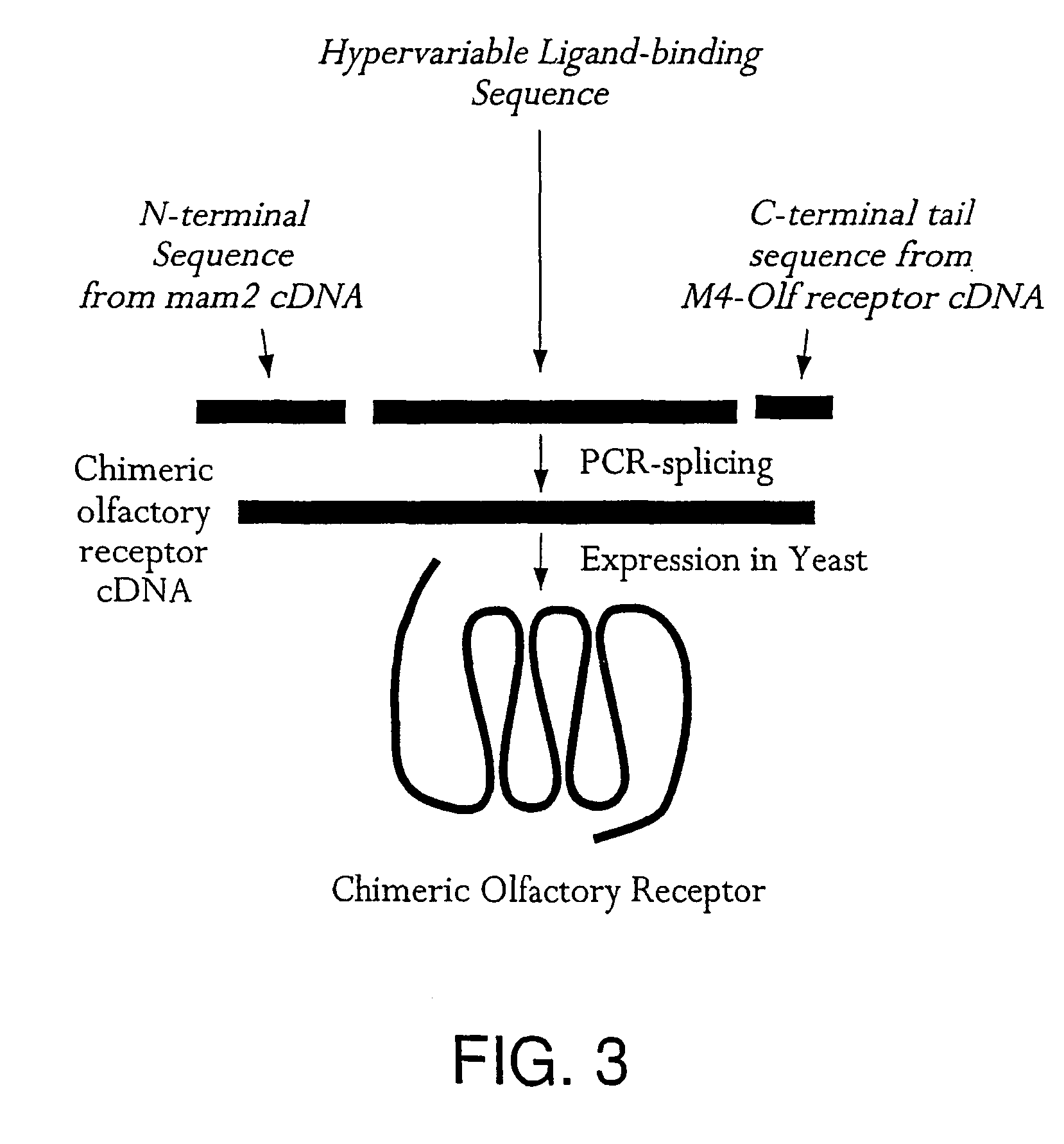Biosensor for defecting chemical agents
a chemical agent and biosensor technology, applied in the field of molecular biosensors, can solve the problems of inability to provide robust biological sensors that can be easily adapted to detect diverse substances, inhibit cloning and expression of olfactory receptors, and not coupled to an appropriate second
- Summary
- Abstract
- Description
- Claims
- Application Information
AI Technical Summary
Benefits of technology
Problems solved by technology
Method used
Image
Examples
example 1
Construction of Yeast Master Strain WIF-1
[0158]The non-variable components of the cAMP signal transduction pathway consisting of the rat M4 Golf alpha subunit, the human G-protein β- and γ-subunits, and type III adenylyl cyclase (AC) were sequentially integrated into the yeast cell using two distinct yeast expression vectors derived from the yeast expression vector pESC. These vectors were:
[0159]
vectorcomponent1. pESCtrp-Golf-cyc-DH5αrat M4 Golf α-subunit; adenylatecyclase2. pESCura-β2γ5-DH5αhuman G-protein β- and γ-subunits
[0160]Vectors 1 and 2 were deposited on Feb. 1, 2001 with the patent culture collection of the National Center for Agricultural Utilization Research, Agricultural Research Service, U.S. Department of Agriculture (NRRL), 1815 North University Street, Peoria, Ill. 61604 U.S.A., in accordance with the Budapest Treaty, and have been assigned accession nos. NRRL B-30412 and NRRL B-30414, respectively. Master yeast strain WIF-1 was deposited on Feb. 7, 2001 with the N...
example 2
Construction of Yeast Reporter Strain WIF-1α
[0171]The WIF-1 host master cell described above can be transfected with signal reporters of different types to form pre-biosensor cells. Transfection vectors comprising three separate signal reporters (for the construction of three separate pre-biosensor cells) have been constructed. These vectors were:
[0172]
vectorcomponent3. pESChis-creb-cregfp-DH5αCREB; CRE-driven GFP4. pESChis-creb-cregal-DH5αCREB; CRE-driven beta galactosidase5. pESChis-ONGC-aeq-DH5αCa++ channel; Apoaequorin
[0173]Vector 3 (pESChis-creb-cregfp-DH5α) was deposited on Feb. 1, 2001 with the patent culture collection of the National Center for Agricultural Utilization Research, Agricultural Research Service, U.S. Department of Agriculture (NRRL), 1815 North University Street, Peoria, Ill. 61604 U.S.A., in accordance with the Budapest Treaty, and has been assigned accession no. NRRL B-30413.
2.1—Construction of the Yeast Expression Reporter Vector pESChis-creb-cregfp-DH5α
[01...
example 3
Transfection of Pre-Biosensor WIF-1α with pESCleu-RI7-DH5α to Form Biosensor WIF-1α-RI7
[0184]Rat olfactory receptor R17, which is responsive to octaldehyde, was cloned by RT-PCR methods using mRNA isolated from rat olfactory epithelium. This receptor was cloned into modified yeast pESC expression vector pESCleu-RI7-DH5α, which was transfected into the olfactory pre-biosensor WIF-1α to produce biosensor WIF-1α-R17.
[0185]3.1—Construction of pESCleu-RI7-DH5α—The rat olfactory receptor R17 receptor was cloned from rat olfactory epithelial lamellae total RNA using RT-PCR. Reverse transcription of the mRNA into DNA was carried out using the Ready-To-Go™ T-Primed First-Strand Kit manufactured by Amersham Pharmacia Biotech Inc., USA using the manufacturer's protocol. The following primers were used for the subsequent amplification of the RI7 receptor:
[0186]
Forward (sense) primer:ATGGAGCGAAGGAACCACAGTGGG(SEQ ID NO: 21)Reverse (antisense) primer:CTAACCAATTTTGCTGCCTTTGTTGG(SEQ ID NO: 22)
[0187...
PUM
| Property | Measurement | Unit |
|---|---|---|
| Fluorescence | aaaaa | aaaaa |
| Level | aaaaa | aaaaa |
Abstract
Description
Claims
Application Information
 Login to View More
Login to View More - R&D
- Intellectual Property
- Life Sciences
- Materials
- Tech Scout
- Unparalleled Data Quality
- Higher Quality Content
- 60% Fewer Hallucinations
Browse by: Latest US Patents, China's latest patents, Technical Efficacy Thesaurus, Application Domain, Technology Topic, Popular Technical Reports.
© 2025 PatSnap. All rights reserved.Legal|Privacy policy|Modern Slavery Act Transparency Statement|Sitemap|About US| Contact US: help@patsnap.com



